This post may contain affiliate links. Please read our disclosure policy.
If you are looking for a zucchini bread recipe that is not quick bread and uses yeast, you need to try this savory soft fluffy zucchini yeast bread. The same recipe can also be used to make zucchini hamburger buns.

It’s not your typical zucchini quickbread
It’s zucchini season and a friend gave us her homegrown zucchini. Since I’m really into baking these past few years, I decided to bake some zucchini bread. When it comes to zucchini and bread, most recipes out there are usually for zucchini quick bread and usually they are sweet versions. I have nothing against quick bread because they are convenient and doesn’t require yeast. But, I love baking bread made with yeast. So, I decided to develop this zucchini yeast bread that is more on the savory side and can be used as morning toast or to make sandwiches or burgers.

Soft fluffy Zucchini Yeast Bread/Buns
Ingredients
- 350 g bread flour (12.7% protein content)
- 20 g sugar
- 200 g grated zucchini
- 5 g instant yeast
- 15 g oil
- 4 g salt
- 70 g juice from zucchini plus more as needed
Egg wash:
- 1 egg beaten
- ½ tsp milk
Topping:
- 1 Tbsp Grated parmesan cheese or more as needed
- ½ cup Shredded cheddar cheese
Instructions
Grate the zucchini:
- Wash the zucchini well, pat it dry and leave the skin on (you can remove it if you prefer). Cut the zucchini in half and scrape out the seeds. The seeds part are watery. Grate the zucchini into fine pieces so it won't be "stringy" when you add it into the dough. Squeeze out as much liquid from the zucchini as possible. This affects the hydration of the dough. Keep the liquid you squeeze out as we will add this back to the dough
- If you are wondering why we squeeze the liquid out of the zucchini but add it back later, it is basically to control the amount of liquid we add to the dough. Zucchini has very high water content and every zucchini has a different amount of liquid. This way, we can ensure that the dough we prepare won't be overly wet and difficult to work with
Prepare the dough:
- Combine all the ingredients for the dough in a mixing bowl of a standmixer. Stir the mixture with the dough hook to combine roughly so the dry ingredients won't start flying when you turn on the machine. Start mixing at speed 2 for about 1 minute and then increase to speed 2 and continue to knead for 7-10 minutes (the timing depends on your mixer too) to get a soft dough is smooth and elastic, slightly sticky to the touch. The dough should reach a windowpane stage. When you gently stretch the dough thinly, it shouldn't tear easily. If it does, knead a bit longer.
- If the dough feels dry and/or stiff, add more zucchini juice, one teaspoon at a time. You want to make sure the dough feels soft and hydrated, this is one of the important tips to get a soft bread. So don't be afraid to add more liquid if you feels like the dough needs it
First proofing:
- Place the dough in a lightly oiled bowl. This is optional but I like to put it in a round container, about 1 quart-size so I can monitor when it doubles in volume. Gently press the dough down so it's flat and fill up the container. I will mark the side of the container with masking tape where the dough would double in volume. This may take about 30-45 minutes at around 79-82 F (26-28 C). It may be faster or take longer, depending on the temperature
- Once the dough has doubled, transfer it to a work surface. Deflate the air by pressing and folding the dough a few times
Shaping for bread loaf:
- Brush your loaf pan with some oil all over. I use use 8 1/2 x 4 1/2 loaf pan. Divide into 3 equal-weight doughs. Round up each dough to roughly form a ball. Cover and let them rest for 5 minutes
- Then work with one dough at a time and keep the rest covered. Flatten the dough with your palm and roll it into a rectangle shape, the width should about twice the width of the loaf pan and about the same length as the loaf pan. Fold the two sides over to meet in the middle and then roll the dough up, not too tight, not too loose, like a Swiss roll
- Place the shaped dough into the pan. Repeat with the other dough. Place all the shaped dough side by side inside the loaf pan. Slightly flatten the three doughs with your palm so they are about the same height
Shaping for hamburger buns:
- Line a large baking sheet with parchment paper. Divide the dough into 6 equal-weight doughs. Round them up into a dough balls by pulling and tucking on the dough. Keep them covered and let them rest for 5 minutes
- Work with one dough at a time, take one dough and flatten with your palm and then pull the edge towards the middle to tighten the dough balls. Place the dough, seam side down, on the prepared baking sheet
Final proofing:
- For bread loaf: Cover and let the dough proof again at a warm place until it fills up about 80-90% of the pan. This may take about 45 minutes to 1 hour or longer at 82 F (28 C). When gently poke on the dough, it bounces back gradually and leave an indentation. The dough is done proofing
- For hamburger buns: Cover and let the dough proof again at a warm place until they are puffy, about 50% larger than original size. This may take about 45 minutes to 1 hour or longer at 82 F (28 C). When gently poke on the dough, it bounces back gradually and leave an indentation. The dough is done proofing
Baking:
- 10 minutes before the end of proofing, if you bake without the lid, preheat your oven to 350 F (180 C) for a conventional oven. For convection top and bottom heat, lower the temperature by 20 F or 15 C
- Whisk the egg with milk for an egg wash. Brush the surface with an egg wash. Sprinkle with parmesan cheese on top
- Place the loaf pan on the middle rack and bake for 25-30 minutes or until golden brown. The internal temperature of the center of the bread should be at least 190 F (88 C). Rotate the pan halfway through baking. If the top gets browned too quickly, tent it loosely with aluminum foil, shiny-side facing up
- For hamburger buns, bake or 15 minutes or until golden brown. The internal temperature of the center of the bread should be at least 190 F (88 C)
Cooling:
- Once out of the oven, drop the pan on the counter to release some steam and immediately remove from the pan onto a cooling rack. For hamburger buns, transfer to a cooling rack
- Optional: If you want a softer shinier crust, you can brush with melted butter immediately while the bread is still warm. Let the bread cool down completely on the rack
RECOMMEDED TOOLS
*Nutrition facts are just estimates and calculated using online tools*

How to bake savory soft fluffy zucchini yeast bread
1. Wash the zucchini well, pat it dry and leave the skin on (you can remove it if you prefer). Cut the zucchini in half and scrape out the seeds. The seeds part are watery. 
2. Grate the zucchini into fine pieces so it won’t be “stringy” when you add it into the dough. Squeeze out as much liquid from the zucchini as possible. This affects the hydration of the dough. Keep the liquid you squeeze out as we will add this back to the dough
3. If you are wondering why we squeeze the liquid out of the zucchini but add it back later, it is basically to control the amount of liquid we add to the dough. Zucchini has very high water content and every zucchini has a different amount of liquid. This way, we can ensure that the dough we prepare won’t be overly wet and difficult to work with
4. Combine all the ingredients for the dough in a mixing bowl of a standmixer. 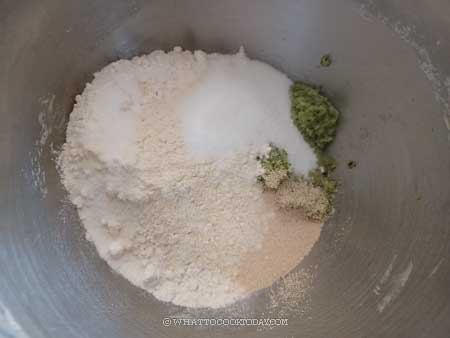
5. Stir the mixture with the dough hook to combine roughly so the dry ingredients won’t start flying when you turn on the machine. 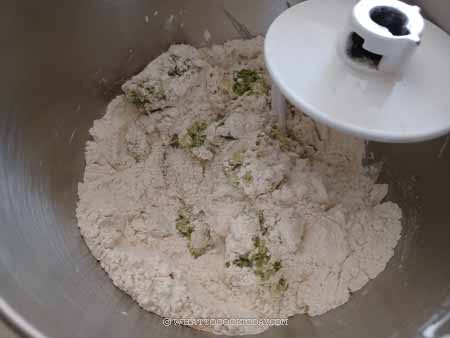
6. Start mixing at speed 2 for about 1 minute and then increase to speed 2 and continue to knead for 7-10 minutes (the timing depends on your mixer too) to get a soft dough that is smooth and elastic, slightly sticky to the touch. The dough should reach a windowpane stage. When you gently stretch the dough thinly, it shouldn’t tear easily. If it does, knead a bit longer.
6. If the dough feels dry and/or stiff, add more zucchini juice, one teaspoon at a time. You want to make sure the dough feels soft and hydrated, this is one of the important tips to get a soft bread. So don’t be afraid to add more liquid if you feels like the dough needs it
7. Place the dough in a lightly oiled bowl. This is optional but I like to put it in a round container, about 1 quart-size so I can monitor when it doubles in volume. Gently press the dough down so it’s flat and fill up the container. I will mark the side of the container with masking tape where the dough would double in volume. This may take about 30-45 minutes at around 79-82 F (26-28 C). It may be faster or take longer, depending on the temperature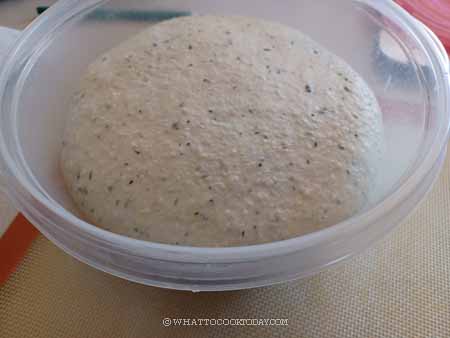
8. Once the dough has doubled, transfer it to a work surface. Deflate the air by pressing and folding the dough a few times. 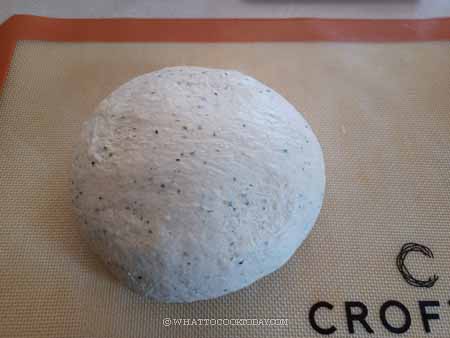
9. FOR BREAD LOAF: Brush your loaf pan with some oil all over. I use 8 1/2 x 4 1/2 loaf pan. Divide into 3 equal-weight doughs. Round up each dough to roughly form a ball. Cover and let them rest for 5 minutes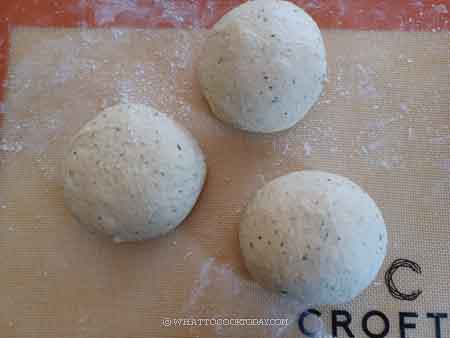
10. Then work with one dough at a time and keep the rest covered. Flatten the dough with your palm and roll it into a rectangle shape, the width should be about twice the width of the loaf pan and about the same length as the loaf pan. 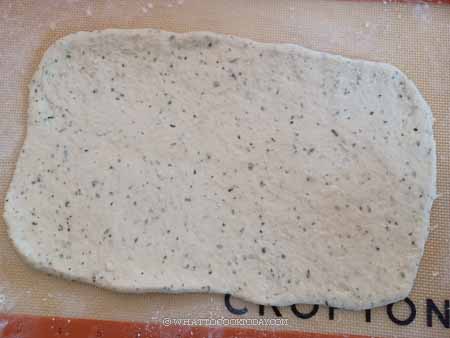
11. Fold the two sides over to meet in the middle and then roll the dough up, not too tight, not too loose, like a Swiss roll
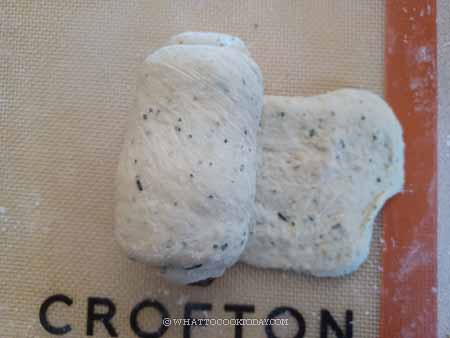
12. Place the shaped dough into the pan. Repeat with the other dough. Place all the shaped dough side by side inside the loaf pan. Slightly flatten the three doughs with your palm so they are about the same height
13. FOR HAMBURGER BUNS: Line a large baking sheet with parchment paper. Divide the dough into 6 equal-weight doughs. Round them up into a dough balls by pulling and tucking on the dough. Keep them covered and let them rest for 5 minutes

14. Work with one dough at a time, take one dough and flatten with your palm and then pull the edge towards the middle to tighten the dough balls. Place the dough, seam side down, on the prepared baking sheet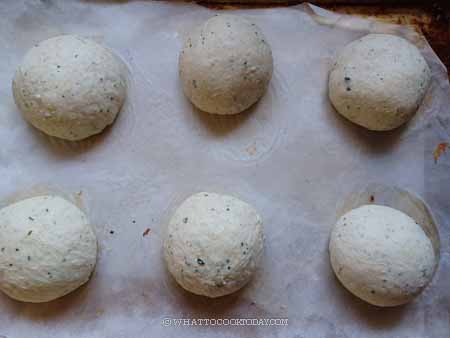
15. For bread loaf: Cover and let the dough proof again at a warm place until it fills up about 80-90% of the pan. This may take about 45 minutes to 1 hour or longer at 82 F (28 C). When gently poke on the dough, it bounces back gradually and leaves an indentation. The dough is done proofing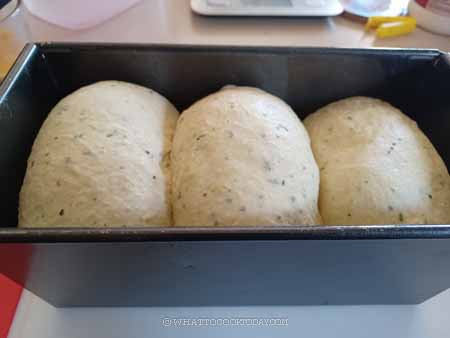
16. For hamburger buns: Cover and let the dough proof again at a warm place until they are puffy, about 50% larger than original size. This may take about 45 minutes to 1 hour or longer at 82 F (28 C). When gently poke on the dough, it bounces back gradually and leave an indentation. The dough is done proofing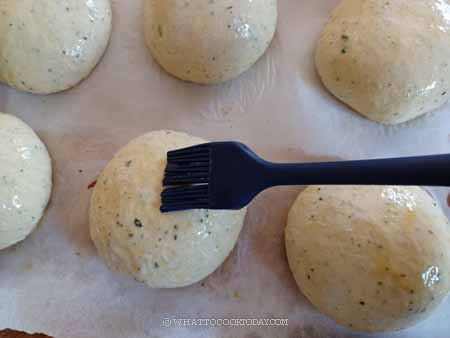
17. 10 minutes before the end of proofing, if you bake without the lid, preheat your oven to 375 F (190 C) for a conventional oven. For convection top and bottom heat, lower the temperature by 20 F or 15 C
Whisk the egg with milk for an egg wash. Brush the surface with an egg wash. Sprinkle with parmesan cheese on top for hamburger buns and shredded cheese for bread loaf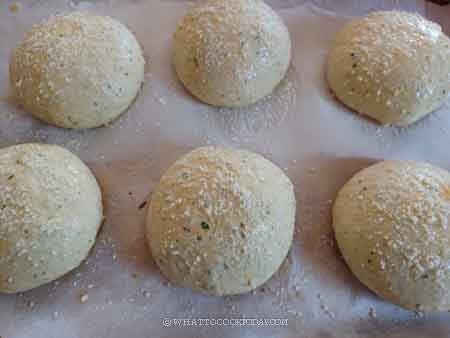

18. Place the loaf pan on the middle rack and bake for 25-30 minutes or until golden brown. The internal temperature of the center of the bread should be at least 190 F (88 C). Rotate the pan halfway through baking. If the top gets browned too quickly, tent it loosely with aluminum foil, shiny-side facing up. For hamburger buns, bake or 15 minutes or until golden brown. The internal temperature of the center of the bread should be at least 190 F (88 C)
19. Once out of the oven, drop the pan on the counter to release some steam and immediately remove from the pan onto a cooling rack. For hamburger buns, transfer to a cooling rack. Optional: If you want a softer shinier crust, you can brush with melted butter immediately while the bread is still warm. Let the bread cool down completely on the rack

Did you make this soft fluffy zucchini yeast bread recipe?
I love it when you guys snap a photo and tag it to show me what you’ve made. Simply tag me @WhatToCookToday #WhatToCookToday on Instagram and I’ll be sure to stop by and take a peek for real!




2 comments
Thanks for sharing your recipe. I had fun with it and the outcome was perfect, fluffy and delicious. Think it’s my best after trying a few recipes . I would highly recommend it to bread-making lovers.
Hello Joy, I can’t be happier to know that the recipe worked out well for you 🙂 Most zucchini bread recipe is a quickbread type, but this yeasted version is also one of my favorites! Thank you for taking time to leave your feedback!